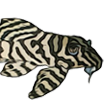Pinton, A, E Fara & O Otero, 2006. Spine anatomy reveals the diversity of catfish through time: a case study of Synodontis (Siluriformes). Naturwissenschaften 93: 22â??26.
Abstract
Synodontis (Mochokidae, Siluriformes) is a freshwater catfish endemic to Africa. The 118 extant species are present in almost all hydrographic basins. Some species are restricted to a single stream, whereas others have a vast distribution. Synodontis is known in the fossil record since the Miocene, and its history depends on the connections among African basins through time. The identification of species in the fossil record is essential to reconstruct this historical pattern. Catfish pectoral and dorsal spines are robust, they preserve well and they form most of the fossil remains for the genus Synodontis. Unfortunately, the criteria for the identification of extant Synodontis species are not applicable to fossil specimens. Here, we define 11 original morphological characters that permit to discriminate four extant species from the Chad-Chari hydrographic system. Six of these characters are defined on pectoral spines and five on dorsal spines. We then show that these characters can be used successfully for identifying fossil specimens. In particular, we present a case study in which we identify Synodontis cf. schall and Brachysynodontis cf. batensoda in the hominid-bearing sector Toros-Menalla (Late Miocene, northern Chad). We show that spine anatomy can be a powerful tool to recognise catfish species through time and thus to identify historical diversity pattern.
Spine diversity of catfish through time
- Silurus
- Posts: 12420
- Joined: 31 Dec 2002, 11:35
- I've donated: $12.00!
- My articles: 55
- My images: 893
- My catfish: 1
- My cats species list: 90 (i:1, k:0)
- Spotted: 424
- Location 1: Singapore
- Location 2: Moderator Emeritus





